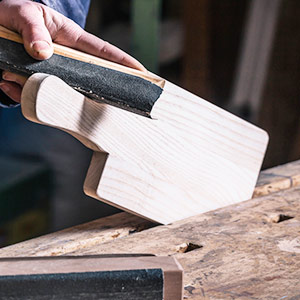Pro tip for breakfast boards: How to avoid cracks
Care for and protect wooden boards
The end-grain edges of the boards - the narrow sides where the annual rings of the wood are visible - are particularly susceptible to cracking. The cause of the cracks is water, which creates tension in the wood as it soaks in and later evaporates. (Only the noble teak wood does not mind contact with water.) A remedy against the formation of cracks is a water-repellent surface coating. The use of food-safe oil is important for this. We recommend treatment with the ARDVOS Wood Oil No. 266.
Step 1 - the preparation
Breakfast boards made of larch and pine should first be treated with sandpaper in different grit sizes. You can start with a grit of 80. The final sanding should be done with 220/240 grit. Before applying the maintenance oil to the boards, be sure to remove all sanding dust.
Step 2 - the oil application
After sanding, the oil is applied to the cutting or breakfast boards. Optimum care of the boards is achieved after three applications.
In the first application, you should especially treat the sensitive end-grain areas extensively. A brush or an old cotton cloth is suitable for application. Excess oil can be removed with a cloth after about 20 minutes. Now the boards should ideally dry for 16 hours.
Before the second application, the wood is given an intermediate sanding with a grain size between 320 and 400. Remember to remove the sanding dust completely here as well before wetting the wood with the care oil. A thin layer of oil is sufficient for the second application. After a quarter of an hour, you can again remove the excess with a cloth.
The third coat is applied without prior sanding and is used to create a gloss. It also contributes to a particularly good water resistance of the breakfast boards. Before using the boards for the first time, they should be left to dry at least overnight.
The correct care of wooden chopping and breakfast boards
The surface protection is preserved longest if you clean the boards without dishwashing detergent using a sponge or brush under cold water and then rinse them under warm water.
Ideally, you should treat your wooden boards once a year according to the instructions above. This keeps the surface hygienic and protected from water.
Do you have questions about the application of ARDVOS wood oil or would you like to care for other wooden furnishings or furniture? Then get in touch with us! The LIVOS expert advisors will be happy to be your contact and provide helpful practical tips about wood and natural colours.


